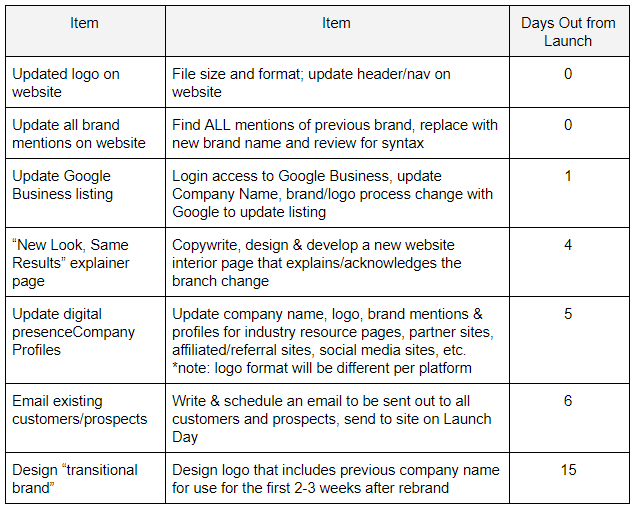A company’s brand is the heart and soul of the organization. It’s what builds recognition, trust, loyalty, and ultimately growth. But sometimes, as a business expands or changes direction, it outgrows its old brand. Their current brand identity is holding them back, and they realize it’s time for a refresh.
Companies don’t always stick with their original branding. And that’s okay. Major brands like Dunkin’ Donuts, Apple, and Uber have all completed a successful brand launch. The key is to take a strategic approach and create a new identity deeply rooted in your company’s mission and vision.
How? First, determine when (and if) a new brand launch campaign is necessary.
Good (and Bad) Reasons for a Brand Launch
We’d be doing you a disservice if we didn’t acknowledge the risks associated with launching a new brand. A brand launch is an exciting opportunity for a business, but it should be conducted for the right reasons and in the right manner. Here are some good and bad reasons to conduct a brand launch campaign:
Good Reasons for a Brand Launch:
- Entering a New Market: If you're introducing a new product or service distinct from your current offerings, a brand launch can help you effectively reach this new market.]
- Rebranding: If your company has undergone significant changes (like a merger or acquisition, or a shift in business strategy) a brand launch can communicate these changes to the public and set new expectations.
- Brand Differentiation: If your brand is struggling to stand out in a crowded market, a brand launch can help differentiate your offerings and position your brand uniquely.
- Revitalizing a Stale Brand: Brands can become outdated or lose relevance over time. A brand launch can reinvigorate your brand, making it more appealing to modern consumers.
Bad Reasons for a Brand Launch:
- Impulsive Decision: A brand launch shouldn't be done on a whim or because it seems like a fun idea. It requires careful planning, substantial investment, and strategic execution
- Copying Competitors: Just because competitors are launching new brands doesn't mean you should, too. Your decisions should be based on your business needs and market research, not what others are doing.
- Expecting Immediate Results: If you're launching a new brand with the expectation of immediate success, you might be disappointed. Building a successful brand takes time and ongoing effort.
- Lack of Resources: A brand launch requires substantial resources, including time, money, and expertise. If you're not ready to make this investment, it's not the right time for a brand launch.
If you still feel that launching a new brand is the right choice, keep reading to learn how to create a successful brand launch strategy.
How to Launch a New Brand in 12 Easy Steps
If your company is planning to launch a new brand, you undoubtedly want to make sure that the change goes over without a hitch. Let’s take a closer look at the brand launch process and outline some easy steps for you to follow.
1: Reestablish Your Brand’s Target Audience
Your brand (new or old) should always be centered around your customers. So, it makes sense that the first step in any brand launch campaign is to identify who your audience is and decide if you’re effectively reaching them with your current identity. Think about how you can better position your brand to connect with these customers.
Take a hard look at your current customer data. Hash out who is buying from you currently. Are these your ideal customers? If not, who is?
Your company wouldn’t have a purpose if it weren’t for your buyers. So any successful brand launch campaign should always start here.
2: Redefine Your Company’s Vision and Purpose
Remember, your brand is your company’s identity. So it should be founded on a clear “why.” Without vision and purpose, your brand will lack the authenticity it needs to genuinely connect with buyers. Ask yourself the following questions:
- What does your company do?
- How does it do it?
- Why is it doing it?
Consider this example from Hotjar, a leading behavior analytics platform. They were able to create a cohesive new identity surrounding their product vision and purpose.
- New Vision: “Transforming user insights into business outcomes, putting people at the center of every product.”
- New Purpose: “Inspiring change through empathy.”
Below is a glimpse into Hotjar’s new brand identity. The logo design, color scheme, typography, and imagery were all fueled by their vision. The icon, made up of two lines, represents the user journey and the “h” in Hotjar. Other brand elements, such as the orbs of color, tie back to heatmaps and Hotjar’s overall purpose.

3: Rebuild Your Brand Identity
Ah, we’ve arrived at the fun part. The actual rebranding process. This is where you create the tangible elements of your brand identity. Here are the elements you’ll want to consider as you go through your new brand launch campaign:
- Logo: Consider your current design before redesigning your logo. How can you recreate it in a forward-thinking way while still keeping some recognizable elements? Isolate some of the best qualities in your current logo and use them to transition toward a new design. Aim for simplicity. Ask yourself if there’s anything you can get rid of or simplify while keeping the attributes that your target customers associate your brand with.
- Color Palette: Color is an important part of branding. In fact, some of the most powerful brands have become synonymous with specific colors. For instance, in the B2B world, HubSpot dominates the world of orange, whereas when you think of LinkedIn, blue probably pops into your head. Consider the psychology behind certain colors in conjunction with your vision and purpose. What colors can you choose that will clarify your brand’s message?
- Typography: Font matters. Just like your color palette, typography can have an effect on the overall impression your brand image gives. When evaluating your font, consider your target audience. Then, consider the personality behind popular typographies. For example, sans serif fonts are more modern and minimal, while slab serif is considered more bold and quirky. You’ll also want to consider readability. Think about your different marketing channels and what fonts show up well.
- Other Imagery: Finally, you’ll also want to consider how other shapes and graphic elements will play into your brand identity. If you’re launching an entirely new brand, you’ll likely need to reconsider your imagery and make sure it fits within the new brand identity.
4: Set a Launch Day
Now that you’ve defined your new brand identity, it’s time to think about execution. When launching a new brand, it’s best to have a clear launch day. This allows for a distinct flip of the switch and ensures you have everything lined up for a seamless transition. We recommend at least 60 days of preparation for a brand launch, to ensure all necessary changes can be made and any potential issues can be addressed.
Here are some considerations for determining an ideal brand launch day:
- Seasonality: Consider the time of year and its impact on your target audience's behavior. Avoid holidays and weekends.
- Day of the Week: Look at your website traffic analytics and determine which day of the week has the highest traffic. This can be a great day to launch your new brand.
- Industry Events: If you are in a specific industry, consider launching at a relevant event or conference where your target audience will be present.
- Competitive Landscape: Keep an eye on what your competitors are doing and try not to launch too close to their major events or releases.
- Internal Readiness: Make sure your team is prepared to handle increased customer inquiries, orders, and potential issues that might arise post-launch.
5: Create a Schedule
Identify the areas where your brand is visible, and plan when and how you will update them. Your list should include every single small item, and might look something like this:

This list is just a sample; your list will be much longer and will include every task prior to launch. Creating a schedule in advance is a great way to stay ahead of changes and cement your brand message well in advance of any implementation. Remember, you might have some items that you add over time, which is to be expected.
6: Build a Transitional Brand
A transitional brand is a great way to get your existing audience used to the new name, look, and brand while acknowledging its previous iteration. It’s like how consumer goods will add “New Look, Same Great Taste!” to their packaging. If you’re simply updating a logo, a transitional brand may not be necessary. However, it is highly recommended when there’s a change in the company name.
It’s best practice to keep the transitional brand on your website and social media for up to six months after rebranding. The goal is to give your existing audience reassurance that they are still in the right place. Once the transition is established and you have no more prospects in the pipeline that would be confused, you can go ahead and remove the transitional brand entirely.
Example of an Effective Transitional Brand
At GoDelta, our team completed a rebranding campaign for a healthcare startup that was changing its name from Fit4D to Cecelia Health. To avoid confusion for their existing audience, we designed a transitional logo that included the new name with a small line under it, “formerly Fit4D”.

7: Develop Brand Launch Messaging
Why is this brand change happening? Your customers and prospects will want to know, and it is in your best interest to make it a transparent and positive change. For Cecelia Health, we created a personalized spin on the brand change. It appealed to the customer as a human, not a sale, and added a hook to get website visitors to want to learn more about the change:
Because of Cecelia
Because of one remarkable CDE, our mission is to improve the health of people living with diabetes and other chronic diseases.
#becauseofcecelia
This messaging inspired social posts and website copy — cluing the audience in on why the change was happening and why it was a benefit for them. While you might not think there’s a story to be told behind a rebrand, there always is one. Learn it, humanize it, and tell your audience about it. They’ll remember the brand and understand the reason behind the change, which is a smart way to decrease any potential churn during a rebrand.
8: Create New Brand Assets
Comb through your existing brand assets and identify any print collateral, digital assets, or promotional products that require rebranding. These might include:
- eBooks
- Case studies
- Infographics
- Lookbooks
- Landing pages
- Email templates
- Call-to-action buttons
- Branded merchandise
- Brochures and data sheets
Develop newly branded versions of these in advance, so on launch day you simply need to update the links to the new files. Keep a list of what you update so you can check them off as you go.
9: Build Out an Explainer Page
An explainer page is a dedicated webpage designed to introduce and explain the new brand to visitors. It serves as a comprehensive guide that helps potential customers understand what the brand is about, what it offers, and how it can benefit them. Your explainer page should be easy to find, so include a link to it in your homepage hero or in a banner at the top of your website.
Related Resource: Rebrand Announcement Example
Take a look at our rebrand explainer page for inspiration.
10: Plan Social Media Transition
Social media platforms have strict rules about how to change your company’s profile and associated pages. These change regularly, so check the respective platform to best anticipate the process.
Some platforms don’t allow a name change and require a new Company Profile or Page to be created. You’ll most likely be able to transfer your existing audience to a new page but check the platform’s requirements before making any changes. For example, you might be required to submit a published press release to corroborate your brand change request, which requires advance coordination with your PR department.
11: Set Up a Paid Advertising Campaign
Revisit your website’s analytics. Which search engines drive the most traffic to your site? Consider creating paid advertising campaigns on these search engines to increase awareness of your brand change.
The strategy here is to bid on your old brand name as well as your new name for the first six months after launch day. Create ad copy that acknowledges the old name and the new name, and creates buzz around it. You want to entice users to learn more about your company and feel positive about the brand change from their first interaction.

12: Set SMART Goals and Report Back After 30 Days
Before launch day, establish a few SMART goals to help you evaluate the performance of your brand launch campaign. SMART goals are specific, measurable, achievable, relevant, and time-bound. Here are a few examples:
- Increase Website Traffic: Increase website traffic by 30% over the next three months by implementing a comprehensive SEO strategy and launching a targeted social media campaign.
- Improve Brand Awareness: Achieve a 25% increase in brand awareness among our target demographic within six months as measured by pre-and post-launch surveys.
- Email Subscriptions: Get 500 new email subscriptions within two months of the brand launch through a dedicated email marketing campaign.
New Brand, Better Results
No matter how established your brand is or how far-reaching your rebranding campaign is, having an actionable strategy and timeline in place will set your company up for success. Follow these steps to bring your old audience along, as well as grow and engage your audience moving forward.
Get in touch if you need assistance developing and executing a brand launch strategy for your business. Our team of experts can help you establish a strong brand identity, craft compelling messaging, and ensure your campaign is executed flawlessly.
Editor's Note: This post was originally published on May 20, 2019, and has been updated for accuracy and current best practices.














